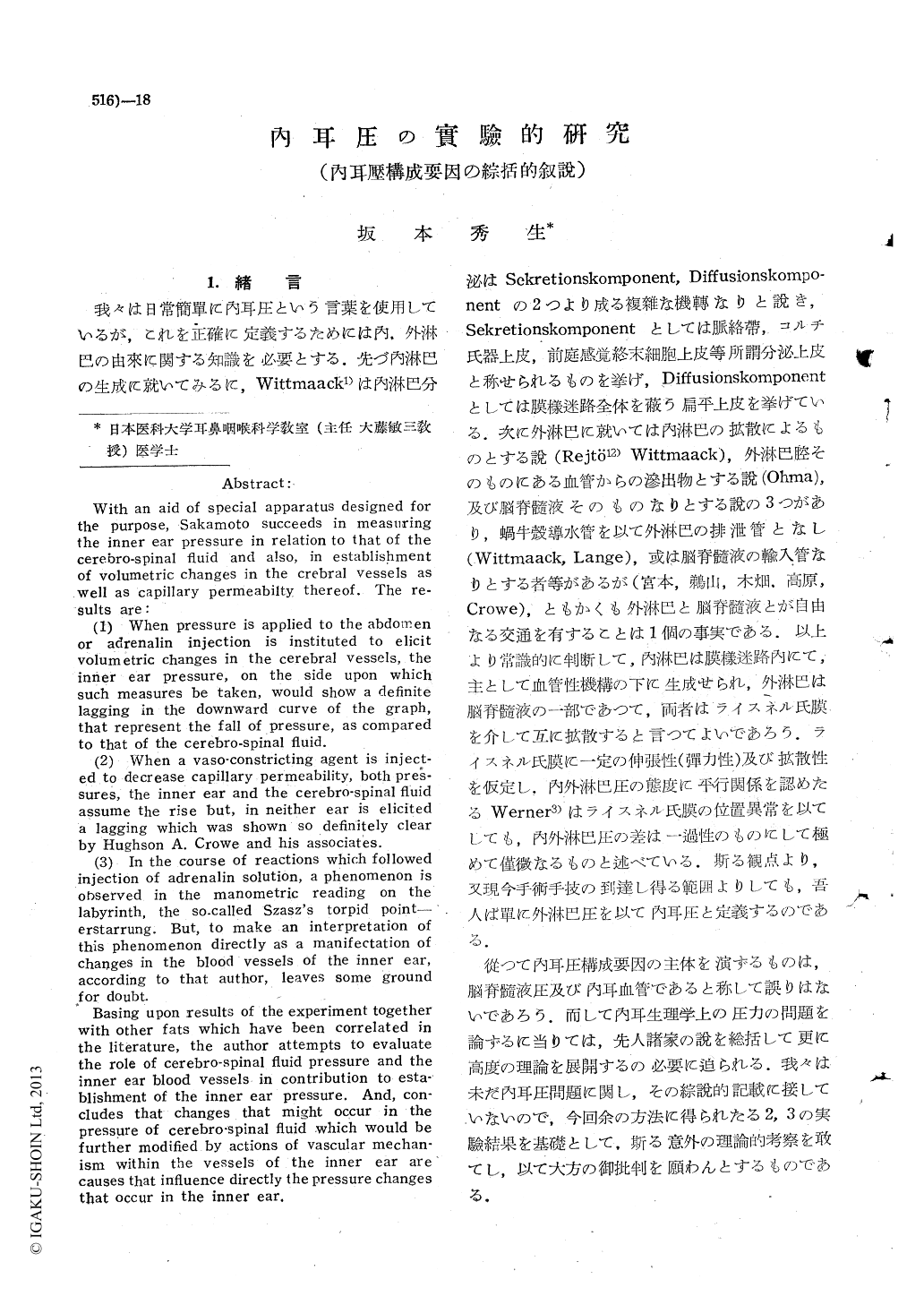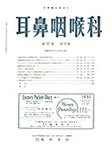- 有料閲覧
- 文献概要
- 1ページ目
1.緒言
我々は日常簡單に内耳圧という言葉を使用しているが,これを正確に定義するためには内,外淋巴の由來に関する知識を必要とする.先づ内淋巴の生成に就いてみるに,Wittmaack1)は内淋巴分泌はSekretionskomponent,Diffusionskomponentの2つより成る複雑な機轉なりと説き,Sekretionskomponentとしては脈絡帶,コルチ氏器上皮,前庭感覚終末細胞上皮等所謂分泌上皮と称せられるものを挙げ,Diffusionskomponentとしては膜樣迷路全体を蔽う扁平上皮を挙げている.次に外淋巴に就いては内淋巴の拡散によるものとする説(Rejtö12) Wittmaack),外淋巴腔そのものにある血管からの滲出物とする説(Ohma),及び脳脊髓液そのものなりとする説の3つがあり,蝸牛殻導水管を以て外淋巴の排泄管となし(Wittmaack,Lange),或は脳脊髓液の輸入管なりとする者等があるが(宮本,鵜山,木畑,高原,Crowe),ともかくも外淋巴と脳脊髓液とが自由なる交通を有することは1個の事実である.以上より常識的に判断して,内淋巴は膜樣迷路内にて,主として血管性機構の下に生成せられ,外淋巴は脳脊髓液の一部であつて,両者はライスネル氏膜を介して互に拡散すると言つてよいであろう.ライスネル氏膜に一定の伸張性(彈力性)及び拡散性を仮定し,内外淋巴圧の態度に平行関係を認めたるWerner3)はライスネル氏膜の位置異常を以てしても,内外淋巴圧の差は一過性のものにして極めて僅微なるものと述べている.斯る観点より,又現今手術手技の到達し得る範囲よりしても,吾人は單に外淋巴圧を以て内耳圧と定義するのである.
從つて内耳圧構域要因の主体を演ずるものは,脳脊髓液圧友び内耳血管であると称して誤りはないであろう.而して内耳生理学上の圧力の問題を.論ずるに当りては,先人諸家の説を総括して更に高度の理論を展開するの必要に迫られる.我々は未だ内耳圧問題に関し,その綜説的記載に接していないので,今回余の方法に得られたる2,3の実驗結果を基礎として,斯る意外の理論的考察を敢てし,以て大方の御批判を願わんとするものである.
With an aid of special apparatus designed for the purpose, Sakamoto succeeds in measuring the inner ear pressure in relation to that of the cerebro-spinal fluid and also, in establishment of volumetric changes in the crebral vessels as well as capillary permeabilty thereof. The results are: (1) When pressure is applied to the abdomen or adrenalin injection is instituted to elicit volumetric changes in the cerebral vessels, the inner ear pressure, on the side upon which such measures be taken, would show a definite lagging in the downward curve of the graph, that represent the fall of pressure, as compared to that of the cerebro-spinal fluid.
(2) When a vasoconstricting agent is injected to decrease capillary permeability, both pressures, the inner ear and the cerebro-spinal fluid assume the rise but, in neither ear is elicited a lagging which was shown so definitely clear by Hughson A. Crowe and his associates.
(3) In the course of reactions which followed injection of adrenalin solution, a phenomenon is observed in the manometric reading on the labyrinth, the so.called Szasz's torpid point-erstarrung. But, to make an interpretation of this phenomenon directly as a manifectation of changes in the blood vessels of the inner ear, according to that author, leaves some ground for doubt.
Basing upon results of the experiment together with other fats which have been correlated in the literature, the author attempts to evaluate the role of cerebro-spinal fluid pressure and the inner ear blood vessels in contribution to establishment of the inner ear pressure. And, concludes that changes that might occur in the pressure of cerebro-spinal fluid which would be further modified by actions of vascular mechanism within the vessels of the inner ear are causes that influence directly the pressure changes that occur in the inner ear.

Copyright © 1950, Igaku-Shoin Ltd. All rights reserved.


